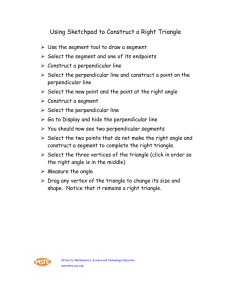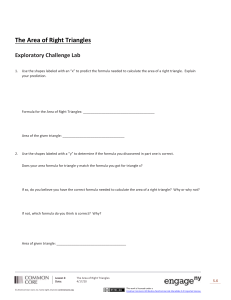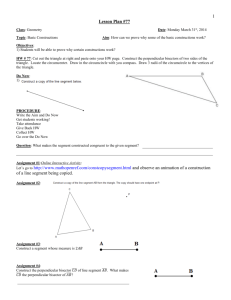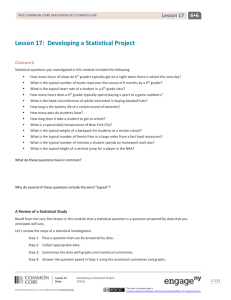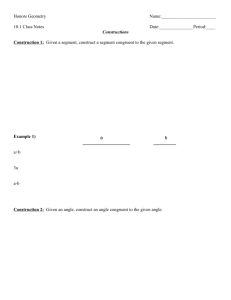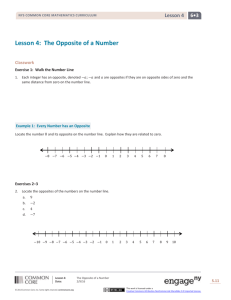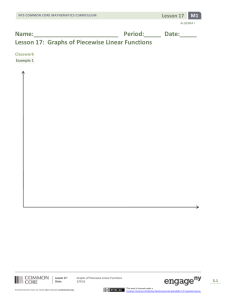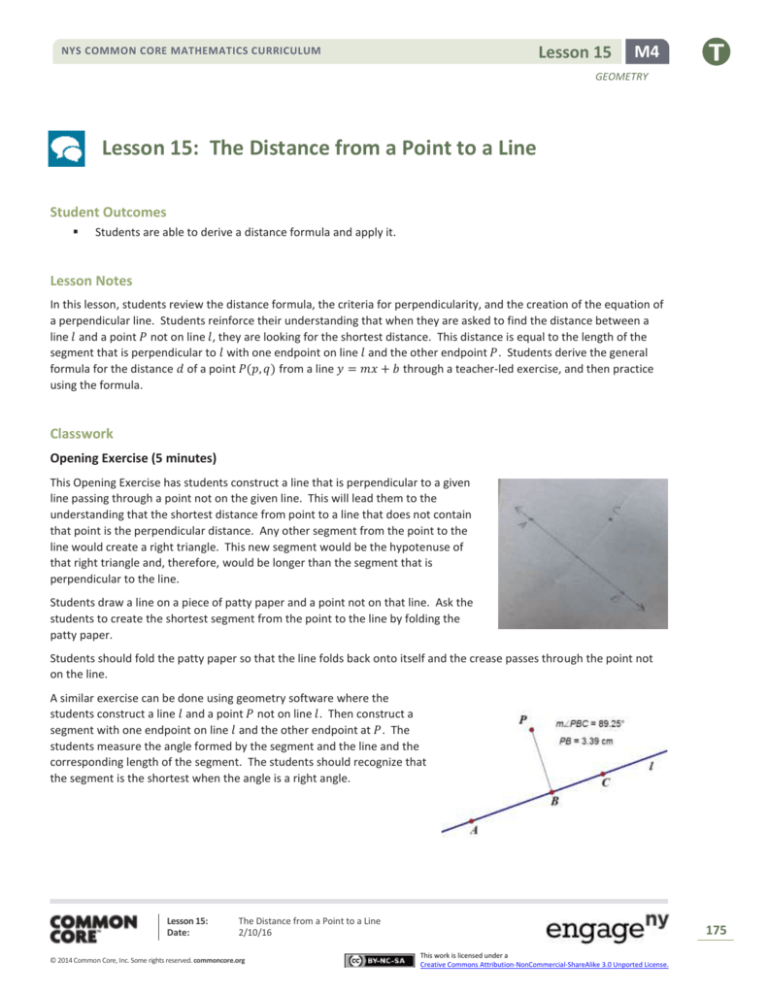
Lesson 15
NYS COMMON CORE MATHEMATICS CURRICULUM
M4
GEOMETRY
Lesson 15: The Distance from a Point to a Line
Student Outcomes
Students are able to derive a distance formula and apply it.
Lesson Notes
In this lesson, students review the distance formula, the criteria for perpendicularity, and the creation of the equation of
a perpendicular line. Students reinforce their understanding that when they are asked to find the distance between a
line 𝑙 and a point 𝑃 not on line 𝑙, they are looking for the shortest distance. This distance is equal to the length of the
segment that is perpendicular to 𝑙 with one endpoint on line 𝑙 and the other endpoint 𝑃. Students derive the general
formula for the distance 𝑑 of a point 𝑃(𝑝, 𝑞) from a line 𝑦 = 𝑚𝑥 + 𝑏 through a teacher-led exercise, and then practice
using the formula.
Classwork
Opening Exercise (5 minutes)
This Opening Exercise has students construct a line that is perpendicular to a given
line passing through a point not on the given line. This will lead them to the
understanding that the shortest distance from point to a line that does not contain
that point is the perpendicular distance. Any other segment from the point to the
line would create a right triangle. This new segment would be the hypotenuse of
that right triangle and, therefore, would be longer than the segment that is
perpendicular to the line.
Students draw a line on a piece of patty paper and a point not on that line. Ask the
students to create the shortest segment from the point to the line by folding the
patty paper.
Students should fold the patty paper so that the line folds back onto itself and the crease passes through the point not
on the line.
A similar exercise can be done using geometry software where the
students construct a line 𝑙 and a point 𝑃 not on line 𝑙. Then construct a
segment with one endpoint on line 𝑙 and the other endpoint at 𝑃. The
students measure the angle formed by the segment and the line and the
corresponding length of the segment. The students should recognize that
the segment is the shortest when the angle is a right angle.
Lesson 15:
Date:
The Distance from a Point to a Line
2/10/16
© 2014 Common Core, Inc. Some rights reserved. commoncore.org
175
This work is licensed under a
Creative Commons Attribution-NonCommercial-ShareAlike 3.0 Unported License.
Lesson 15
NYS COMMON CORE MATHEMATICS CURRICULUM
M4
GEOMETRY
Discussion (2 minutes)
How do you know the segment you created is the shortest segment from the point to the line?
This segment is perpendicular to the line, so it must be the shortest. Any other segment from the point
to the line would create a right triangle. This new segment would be the hypotenuse of that right
triangle and, therefore, would be longer than the segment that is perpendicular to the line.
How can we determine the distance point 𝐶 is from line 𝐴𝐵?
We could measure the length of the perpendicular segment that we created that has one endpoint on
line 𝐴𝐵 and the other at point 𝑃.
Exercise 1 (8 minutes)
Scaffolding:
Exercise 1
A robot is moving along the line 𝟐𝟎𝒙 + 𝟑𝟎𝒚 = 𝟔𝟎𝟎. A homing beacon sits at the point (𝟑𝟓, 𝟒𝟎).
a.
Where on this line will the robot hear the loudest ping?
Students will need to determine the equation of the line passing through the point
(𝟑𝟓, 𝟒𝟎) that is perpendicular to the line 𝟐𝟎𝒙 + 𝟑𝟎𝒚 = 𝟔𝟎𝟎. The slope of this line
𝟐
𝟑
is − .
𝒚 − 𝟒𝟎 =
𝟑
𝟑
(𝒙 − 𝟑𝟓) or 𝒚 = (𝒙 − 𝟑𝟓) + 𝟒𝟎
𝟐
𝟐
There are a variety of methods available to students to use to determine the point
where these two lines intersect. Using substitution is one of the more efficient
methods.
For struggling learners the
question can be changed
to ask, “Where on this line
will the robot be closest to
the beacon?” Show a
picture of the line and the
beacon, and ask students
to estimate their answer.
For advanced learners the
coordinates of the homing
beacon can be changed to
(40, 50).
𝟑
𝟐𝟎𝒙 + 𝟑𝟎 ( (𝒙 − 𝟑𝟓) + 𝟒𝟎) = 𝟔𝟎𝟎
𝟐
𝟐𝟎𝒙 + 𝟒𝟓𝒙 − 𝟏𝟓𝟕𝟓 + 𝟏𝟐𝟎𝟎 = 𝟔𝟎𝟎
𝟔𝟓𝒙 = 𝟗𝟕𝟓
𝒙 = 𝟏𝟓
𝟑
(𝟏𝟓 − 𝟑𝟓) + 𝟒𝟎
𝟐
𝒚 = 𝟏𝟎
𝒚=
The robot will be closest to the beacon when it
is on the point (𝟏𝟓, 𝟏𝟎).
b.
At this point, how far will the robot be from the beacon?
Students need to calculate the distance between the two points
𝑩(𝟑𝟓, 𝟒𝟎) and 𝑨(𝟏𝟓, 𝟏𝟎). Encourage students to think about the
right triangle that is created if one moves from 𝑨 to 𝑩 in two moves:
one horizontal and the other vertical.
𝑨𝑩 = √(𝟑𝟓 − 𝟏𝟓)𝟐 + (𝟒𝟎 − 𝟏𝟎)𝟐
𝑨𝑩 = √(𝟐𝟎)𝟐 + (𝟑𝟎)𝟐
𝑨𝑩 = √𝟏𝟑𝟎𝟎 = 𝟏𝟎√𝟏𝟑
Lesson 15:
Date:
The Distance from a Point to a Line
2/10/16
© 2014 Common Core, Inc. Some rights reserved. commoncore.org
176
This work is licensed under a
Creative Commons Attribution-NonCommercial-ShareAlike 3.0 Unported License.
Lesson 15
NYS COMMON CORE MATHEMATICS CURRICULUM
M4
GEOMETRY
Example 1 (12 minutes)
Scaffolding:
In this example students develop a formula for the distance 𝑑 that a point 𝑃(𝑝, 𝑞) is from
the line 𝑙 given by the equation 𝑦 = 𝑚𝑥 + 𝑏. That is, we only know the point 𝑃 and the
line 𝑙, we do not know where to drop the perpendicular from 𝑃 to 𝑙 algebraically.
We can do this with a construction, but then we would not know the coordinates of the
intersection point 𝑅.
For advanced learners,
assign this as a partner or
small group exercise
instead of a teacher led
example.
Since 𝑅 is some point on the line 𝑙, let’s call it 𝑅(𝑟, 𝑠); it is our goal to first find the values of 𝑟 and 𝑠 in terms of 𝑝, 𝑞, 𝑚,
and 𝑏. To accomplish this we note that ̅̅̅̅
𝑃𝑅 ⊥ 𝑙 allows us to use the formula from Lesson 5 (and Lesson 8). To use this
formula, we will need a segment on line 𝑙. In this example, we chose to use 𝑇(𝑟 + 1, 𝑚(𝑟 + 1) + 𝑏). By strategically
choosing point 𝑅(𝑟, 𝑚𝑟 + 𝑏) and 𝑇(𝑟 + 1, 𝑚(𝑟 + 1) + 𝑏) when we apply the formula from Lesson 5, the second set of
differences reduces nicely. Recall that we developed this formula by translating the figure so that the image of the
vertex of the right angle, in this example, it would be 𝑅′, was at the origin. When we do this, the coordinates of the
image of the other endpoint of the segment, 𝑇′ in this example, will have coordinates (1, 𝑚).
PROOF:
Let 𝑙 be a line given by the graph of the equation 𝑦 = 𝑚𝑥 + 𝑏 (for some real numbers 𝑚 and 𝑏) and let 𝑃(𝑝, 𝑞) be a
point not on line 𝑙. To find point 𝑅(𝑟, 𝑠) in terms of 𝑝, 𝑞, 𝑚, and 𝑏 such that ⃡𝑅𝑃 ⊥ 𝑙 , consider points 𝑅(𝑟, 𝑚𝑟 + 𝑏) and
𝑇(𝑟 + 1, 𝑚(𝑟 + 1) + 𝑏) on the line 𝑙.
How do we know that the points 𝑅(𝑟, 𝑚𝑟 + 𝑏) and 𝑇(𝑟 + 1, 𝑚(𝑟 + 1) + 𝑏) lie on line 𝑙?
We know both points lie on line 𝑙 because their
coordinates are of the form (𝑥, 𝑚𝑥 + 𝑏).
Direct students to construct a diagram depicting the relationships
described above or provide the diagram show to the right.
If 𝑃𝑅 represents the distance from 𝑃 to line 𝑙, what do we
know about the relationship between ̅̅̅̅
𝑃𝑅 and line 𝑙?
̅̅̅̅
𝑃𝑅 must be perpendicular line 𝑙.
What kind of triangle is △ 𝑃𝑇𝑅?
△ 𝑃𝑇𝑅 is a right triangle with the right angle at vertex 𝑅. Which means ̅̅̅̅
𝑃𝑅 ⊥ ̅̅̅̅
𝑅𝑇.
̅̅̅̅
̅̅̅̅
This means 𝑃𝑅 ⊥ 𝑅𝑇
Scaffolding:
↔ (𝑝 − 𝑟)(1) + (𝑞 − (𝑚𝑟 + 𝑏))(𝑚) = 0
For struggling learners,
↔ 𝑝 − 𝑟 + 𝑞𝑚 − 𝑚2 𝑟 − 𝑏𝑚 = 0
review Lesson 5, Example
↔ −𝑟 − 𝑚2 𝑟 = −𝑝 − 𝑞𝑚 + 𝑏𝑚
2.
↔ 𝑟(1 + 𝑚2 ) = 𝑝 + 𝑞𝑚 − 𝑏𝑚
𝑝 + 𝑞𝑚 − 𝑏𝑚
↔𝑟=
1 + 𝑚2
This gives us the coordinates for points 𝑅 and 𝑃 in terms of 𝑝, 𝑞, 𝑚, and 𝑏.
𝑅(
𝑝+𝑞𝑚−𝑏𝑚
1+𝑚2
,𝑚(
Lesson 15:
Date:
𝑝+𝑞𝑚−𝑏𝑚
1+𝑚2
) + 𝑏) and 𝑃(𝑝, 𝑞)
The Distance from a Point to a Line
2/10/16
© 2014 Common Core, Inc. Some rights reserved. commoncore.org
177
This work is licensed under a
Creative Commons Attribution-NonCommercial-ShareAlike 3.0 Unported License.
Lesson 15
NYS COMMON CORE MATHEMATICS CURRICULUM
M4
GEOMETRY
We can now find the distance 𝑑 between points 𝑃 and 𝑅 using the distance formula.
𝑑 = √(𝑥2 − 𝑥1 )2 + (𝑦2 − 𝑦1 )2
𝑑 = √(
2
2
𝑝 + 𝑞𝑚 − 𝑏𝑚
𝑝 + 𝑞𝑚 − 𝑏𝑚
−
𝑝)
+
(𝑚
(
)
+
𝑏
−
𝑞)
1 + 𝑚2
1 + 𝑚2
Understanding this formula addresses standard A-SSE.A.1b (interpret complicated expressions by viewing one or more
of their parts as a single entity).
What are the coordinates of point 𝑃 in terms of 𝑝, 𝑞, 𝑚, and 𝑏?
What are the coordinates of point 𝑅 in terms of 𝑝, 𝑞, 𝑚, and 𝑏?
MP.7
1+𝑚2
) + 𝑏)
Point 𝑃
Point 𝑅
Yes.
No.
We could create a calculator or computer program that asks us to input the values of 𝑝, 𝑞, 𝑚, and 𝑏
and will return the corresponding distance.
Are there limitations to this formula?
𝑝+𝑞𝑚−𝑏𝑚
How might this formula be best used?
,𝑚(
This formula is quite cumbersome. Do you feel it is realistic to expect us to memorize this formula and use it
“by hand” on a regular basis?
1+𝑚2
Does this formula allow us to calculate the distance between the point 𝑃 and the line 𝑙 knowing only
coordinates of the point 𝑃(𝑝, 𝑞) and the equation of the line 𝑦 = 𝑚𝑥 + 𝑏?
𝑝+𝑞𝑚−𝑏𝑚
Which point represents (𝑥2 , 𝑦2 ) in the distance formula?
(
Which point represents (𝑥1 , 𝑦1 ) in the distance formula?
(𝑝, 𝑞)
The formula depends on a real number value for 𝑚; therefore, the line 𝑙
cannot be vertical.
How could we calculate the distance from 𝑃 to the line 𝑙 if 𝑙 were vertical?
We would only need to look at the differences in the 𝑥-coordinates between
points 𝑃and 𝑅.
Lesson 15:
Date:
The Distance from a Point to a Line
2/10/16
© 2014 Common Core, Inc. Some rights reserved. commoncore.org
178
This work is licensed under a
Creative Commons Attribution-NonCommercial-ShareAlike 3.0 Unported License.
Lesson 15
NYS COMMON CORE MATHEMATICS CURRICULUM
M4
GEOMETRY
Exercise 2 (10 minutes)
Students apply the formula for distance found in the previous example to a variety of problems. Students can solve
several of these problems using alternate methods to check that the formula does in fact work.
Exercise 2
For the following problems, use the formula to calculate the distance between the point 𝑷 and the line 𝒍.
𝟐
𝟐
𝒑 + 𝒒𝒎 − 𝒃𝒎
𝒑 + 𝒒𝒎 − 𝒃𝒎
𝒅 = √(
−
𝒑)
+
(𝒎
(
)
+
𝒃
−
𝒒)
𝟏 + 𝒎𝟐
𝟏 + 𝒎𝟐
a.
𝑷(𝟎, 𝟎) and the line 𝒚 = 𝟏𝟎
𝒑 = 𝟎, 𝒒 = 𝟎, 𝒎 = 𝟎, and 𝒃 = 𝟏𝟎
𝟐
𝟐
𝟎 + 𝟎 − 𝟏𝟎(𝟎)
𝟎 + 𝟎 − 𝟏𝟎(𝟎)
𝒅 = √(
− 𝟎) + (𝟎 (
) + 𝟏𝟎 − 𝟎)
𝟏 + 𝟎𝟐
𝟏 + 𝟎𝟐
𝒅 = √𝟎 + (𝟏𝟎)𝟐
𝒅 = 𝟏𝟎
b.
𝑷(𝟎, 𝟎) and the line 𝒚 = 𝒙 + 𝟏𝟎
𝒑 = 𝟎, 𝒒 = 𝟎, 𝒎 = 𝟏, and 𝒃 = 𝟏𝟎
𝟐
𝟐
𝟎 + 𝟎(𝟏) − 𝟏𝟎(𝟏)
𝟎 + 𝟎(𝟏) − 𝟏𝟎(𝟏)
𝒅 = √(
− 𝟎) + (𝟏 (
) + 𝟏𝟎 − 𝟎)
𝟏 + 𝟏𝟐
𝟏 + 𝟏𝟐
𝟐
𝟏𝟎 𝟐
−𝟏𝟎
𝒅 = √( ) + (
+ 𝟏𝟎)
𝟐
𝟐
𝟏𝟎 𝟐
𝟏𝟎 𝟐
𝒅 = √( ) + ( )
𝟐
𝟐
𝒅 = √𝟓𝟐 + 𝟓𝟐
𝒅 = √𝟐(𝟓𝟐 )
𝒅 = 𝟓√𝟐
Lesson 15:
Date:
The Distance from a Point to a Line
2/10/16
© 2014 Common Core, Inc. Some rights reserved. commoncore.org
179
This work is licensed under a
Creative Commons Attribution-NonCommercial-ShareAlike 3.0 Unported License.
M4
Lesson 15
NYS COMMON CORE MATHEMATICS CURRICULUM
GEOMETRY
c.
𝑷(𝟎, 𝟎) and the line 𝒚 = 𝒙 − 𝟔
𝒑 = 𝟎, 𝒒 = 𝟎, 𝒎 = 𝟏, and 𝒃 = −𝟔
𝟐
𝟐
𝟎 + 𝟎(𝟏) − (−𝟔)(𝟏)
𝟎 + 𝟎(𝟏) − (−𝟔)(𝟏)
𝒅 = √(
− 𝟎) + (𝟏 (
) + (−𝟔) − 𝟎)
𝟐
𝟐
𝟏+𝟏
𝟏+𝟏
𝟐
𝟔 𝟐
𝟔
𝒅 = √( ) + (( ) + (−𝟔))
𝟐
𝟐
𝒅 = √𝟑𝟐 + 𝟑𝟐
𝒅 = √𝟐(𝟑𝟐 )
𝒅 = 𝟑√𝟐
̅̅̅̅ to calculate the
Note: Students can also use the isosceles right triangle (45°–45°–90°) that has a hypotenuse of 𝑃𝑅
distance from 𝑃 to 𝑙 to confirm the results obtained using the formula in parts (b) and (c).
Closing (3 minutes)
Ask students to respond to these questions individually in writing, with a partner, or as a class.
Before today’s lesson how did you determine the distance from a line to a point not on the line?
What advantage does our newly discovered formula 𝑑 = √(
We had to find the point of intersection of the given line and the line perpendicular to the given line
through the point not on the line. Then we used the formula 𝑑 = √(𝑥2 − 𝑥1 )2 + (𝑦2 − 𝑦1 )2 to find the
distance between the two points.
𝑝+𝑞𝑚−𝑏𝑚
1+𝑚2
2
− 𝑝) + (𝑚 (
𝑝+𝑞𝑚−𝑏𝑚
1+𝑚2
2
) + 𝑏 − 𝑝) offer?
Now we do not need to find the other endpoint of the shortest segment from the given line to the point
not on the line. If we know the equation of the given line and the coordinates of the point not on the
line, we have enough information to calculate the distance from the point to the line. The formula is
cumbersome to apply in the majority of cases; therefore, it would be most efficient to write a calculator
or computer program that uses this formula to calculate distances for given values of 𝑝, 𝑞, 𝑚, and 𝑏
In each of the exercises we were able to also calculate the distance using an isosceles right triangle. Will this
method always apply, or are there certain conditions that make this possible?
The segment that represented the distance from the point 𝑃 to the line 𝑙 was the hypotenuse of an
isosceles right triangle because the line had a slope of 1 or −1.
Exit Ticket (5 minutes)
Lesson 15:
Date:
The Distance from a Point to a Line
2/10/16
© 2014 Common Core, Inc. Some rights reserved. commoncore.org
180
This work is licensed under a
Creative Commons Attribution-NonCommercial-ShareAlike 3.0 Unported License.
Lesson 15
NYS COMMON CORE MATHEMATICS CURRICULUM
M4
GEOMETRY
Name
Date
Lesson 15: The Distance from a Point to a Line
Exit Ticket
1.
Find the distance between the point 𝑃(0,0) and the line 𝑦 = −𝑥 + 4 using the formula from today’s lesson.
2.
Verify using another method.
Lesson 15:
Date:
The Distance from a Point to a Line
2/10/16
© 2014 Common Core, Inc. Some rights reserved. commoncore.org
181
This work is licensed under a
Creative Commons Attribution-NonCommercial-ShareAlike 3.0 Unported License.
Lesson 15
NYS COMMON CORE MATHEMATICS CURRICULUM
M4
GEOMETRY
Exit Ticket Sample Solutions
1.
Find the distance between the point 𝑷(𝟎, 𝟎) and the line 𝒚 = −𝒙 + 𝟒 using the formula from today’s lesson.
𝟐
𝟐
𝒑 + 𝒒𝒎 − 𝒃𝒎
𝒑 + 𝒒𝒎 − 𝒃𝒎
𝒅 = √(
− 𝒑) + (𝒎 (
) + 𝒃 − 𝒒)
𝟐
𝟐
𝟏+𝒎
𝟏+𝒎
𝒑 = 𝟎, 𝒒 = 𝟎, 𝒎 − 𝟏, and 𝒃 = 𝟒
𝟐
𝟐
𝟎 + 𝟎(−𝟏) − 𝟒(−𝟏)
𝟎 + 𝟎(−𝟏) − 𝟒(−𝟏)
𝒅 = √(
− 𝟎) + ((−𝟏) (
) + 𝟒 − 𝟎)
𝟏 + (−𝟏)𝟐
𝟏 + 𝟏𝟐
𝟐
𝟒 𝟐
𝟒
𝒅 = √( ) + ((−𝟏) ( ) + 𝟒)
𝟐
𝟐
𝒅 = √𝟐𝟐 + 𝟐𝟐
𝒅 = √𝟐(𝟐𝟐 )
𝒅 = 𝟐√𝟐
2.
Verify using another method.
Note: Most students will also use the isosceles right triangle (45°–45°–90°) shown below that has a hypotenuse of ̅̅̅̅
𝑃𝑅
to calculate the distance from 𝑃 to 𝑙 to confirm the results obtained using the formula.
Lesson 15:
Date:
The Distance from a Point to a Line
2/10/16
© 2014 Common Core, Inc. Some rights reserved. commoncore.org
182
This work is licensed under a
Creative Commons Attribution-NonCommercial-ShareAlike 3.0 Unported License.
Lesson 15
NYS COMMON CORE MATHEMATICS CURRICULUM
M4
GEOMETRY
Problem Set Sample Solutions
1.
Given △ 𝑨𝑩𝑪 with vertices 𝑨(𝟑, −𝟏), 𝑩(𝟐, 𝟐), and 𝑪(𝟓, 𝟏).
a.
Find the slope of the angle bisector of ∠𝑨𝑩𝑪.
slope = −𝟏
b.
̅̅̅̅.
Prove that the bisector of ∠𝑨𝑩𝑪 is the perpendicular bisector of 𝑨𝑪
̅̅̅̅.
̅̅̅̅̅ be the bisector of ∠𝑨𝑩𝑪, where 𝑫 is the point of interection with 𝑨𝑪
Let 𝑩𝑫
𝑨𝑩 = 𝑪𝑩 = √𝟏𝟎; therefore, △ 𝑨𝑩𝑪 is isosceles, and 𝒎∠𝑨 = 𝒎∠𝑪 (base angles of isosceles have equal
measures).
𝒎∠𝑨𝑩𝑫 = 𝒎∠𝑪𝑩𝑫 by definition of angle bisector.
△ 𝑨𝑩𝑫 ≅△ 𝑪𝑩𝑫 by ASA.
𝑨𝑫 = 𝑪𝑫, since corresponding sides of congruent triangles have equal lengths; therefore, ̅̅̅̅̅
𝑩𝑫 bisects ̅̅̅̅
𝑨𝑪.
The slope of ̅̅̅̅
𝑨𝑫 is −𝟏; therefore, ̅̅̅̅
𝑨𝑫 ⊥ ̅̅̅̅
𝑨𝑪.
Therefore, ̅̅̅̅
𝑨𝑫 is the perpendicular bisector of ̅̅̅̅
𝑨𝑪.
c.
̅̅̅̅.
Write the equation of the line containing 𝑨𝑫
𝒚 = −𝒙 + 𝟒
2.
Use the distance formula from today’s lesson to find the distance between the point 𝑷(−𝟐, 𝟏) and the line 𝒚 = 𝟐𝒙.
𝒑 = −𝟐, 𝒒 = 𝟏, 𝒎 = 𝟐, and 𝒃 = 𝟎
𝟐
𝟐
𝒑 + 𝒒𝒎 − 𝒃𝒎
𝒑 + 𝒒𝒎 − 𝒃𝒎
𝒅 = √(
− 𝒑) + (𝒎 (
) + 𝒃 − 𝒒)
𝟐
𝟐
𝟏+𝒎
𝟏+𝒎
𝟐
𝟐
−𝟐 + 𝟏(𝟐) − 𝟎(𝟐)
−𝟐 + 𝟏(𝟐) − 𝟎(𝟐)
𝒅 = √(
− (−𝟐)) + (𝟐 (
) + 𝟎 + 𝟏)
𝟐
𝟐
𝟏+𝟐
𝟏+𝟐
𝟐
𝟐
𝟎
𝟎
𝒅 = √( + 𝟐) + (𝟐 ( ) + 𝟏)
𝟓
𝟓
𝒅 = √(𝟐)𝟐 + (𝟏)𝟐
𝒅 = √𝟓
3.
Confirm the results obtained in Problem 1 using another method.
̅̅̅̅ is the hypotenuse of the right triangle with vertices 𝑷(−𝟐, 𝟏), 𝑹(𝟎, 𝟎), and (−𝟐, 𝟎). Using the Pythagorean
𝑷𝑹
theorem, we find that = √𝟐𝟐 + 𝟏𝟐 = √𝟓 .
Lesson 15:
Date:
The Distance from a Point to a Line
2/10/16
© 2014 Common Core, Inc. Some rights reserved. commoncore.org
183
This work is licensed under a
Creative Commons Attribution-NonCommercial-ShareAlike 3.0 Unported License.
NYS COMMON CORE MATHEMATICS CURRICULUM
Lesson 15
M4
GEOMETRY
4.
Find the perimeter of quadrilateral 𝑫𝑬𝑩𝑭 shown below.
⃡ which would make 𝒎 = −𝟏 instead of 𝟏).
⃡ is 𝒚 = 𝒙 + 𝟖 (students may also choose to use 𝑩𝑪
The equation of 𝑨𝑩
𝒑 = 𝟎, 𝒒 = 𝟎, 𝒎 = 𝟏, and 𝒃 = 𝟖
𝟐
𝟐
𝒑 + 𝒒𝒎 − 𝒃𝒎
𝒑 + 𝒒𝒎 − 𝒃𝒎
𝑬𝑫 = √(
− 𝒑) + (𝒎 (
) + 𝒃 − 𝒒)
𝟐
𝟐
𝟏+𝒎
𝟏+𝒎
𝟐
𝟐
𝟎 + 𝟎(𝟏) − 𝟖(𝟏)
𝟎 + 𝟎(𝟏) − 𝟖(𝟏)
𝑬𝑫 = √(
− 𝟎) + (𝟏 (
) + 𝟖 − 𝟎)
𝟏 + 𝟏𝟐
𝟏 + 𝟏𝟐
𝟐
−𝟖 𝟐
−𝟖
𝑬𝑫 = √( ) + (( ) + 𝟖)
𝟐
𝟐
𝟐
−𝟖 𝟐
−𝟖
𝑬𝑫 = √( ) + (( ) + 𝟖)
𝟐
𝟐
𝑬𝑫 = √𝟒𝟐 + 𝟒𝟐
𝑬𝑫 = 𝟒√𝟐
̅̅̅̅ with length 𝟖 and leg 𝑬𝑫
̅̅̅̅ with length 𝟒√𝟐. This means that △ 𝑨𝑬𝑫
△ 𝑨𝑬𝑫 is a right triangle with hypotenuse 𝑨𝑫
is an isosceles right triangle (𝟒𝟓°–𝟒𝟓°–𝟗𝟎°), which means 𝑨𝑬 = 𝟒√𝟐. We also know that △ 𝑨𝑬𝑫 ≅△ 𝑫𝑬𝑩 ≅
△ 𝑩𝑭𝑫 ≅ △ 𝑫𝑭𝑪 because they are all right triangles with hypotenuse of length 𝟖 and leg of length 𝟒√𝟐. Therefore,
the perimeter of 𝑫𝑬𝑩𝑭 is 𝟒(𝟒√𝟐) = 𝟏𝟔√𝟐.
Lesson 15:
Date:
The Distance from a Point to a Line
2/10/16
© 2014 Common Core, Inc. Some rights reserved. commoncore.org
184
This work is licensed under a
Creative Commons Attribution-NonCommercial-ShareAlike 3.0 Unported License.



